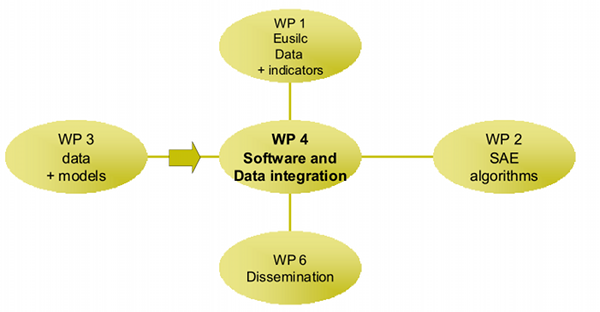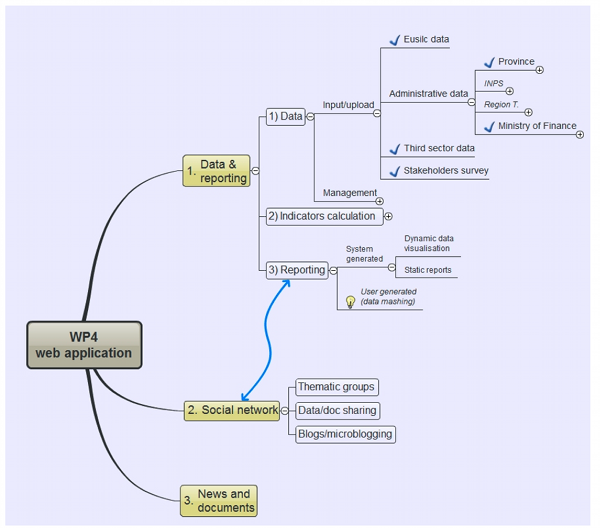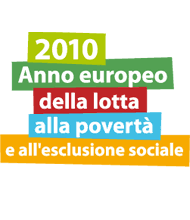Summary
WP 4 concerns the development of a software application that could be used by the Local Observatory on Poverty and Social Exclusion (see WP 3) to monitor Laeken indicators at LAU1 and LAU2 level and to disseminate results to improve the knowledge of the phaenomena and the local social policies. The software allows to store and update the raw administrative data locally available (see WP 3), to link them with EU-SILC 2008 oversampling micro-data, to estimate indicators using correction models based on small area methodology (see WP3, task 3.3), to disseminate results between local stakeholders, promoting their capabilities in fighting and preventing social exclusion.
WP4 objectives
The aim of WP4 is to develop a software application whose purpose is to give unskilled users (i.e. local policy makers, social workers from public and private sector) an easy-to-use tool for managing data and indicators at LAU1 and LAU2 level. The software objectives are:
- give a real-world application of SAMPLE results;
- support policy-making and implementation at the local level;
- contribute to the public debate by creating information-rich, easy to use, easy-to-understand graphics (unveiling the meaning of data without hiding their complexity);
- share knowledge and improve local capabilities.
The long-term objective (outcome) of WP4 is to improve the understanding of the social exclusion processes at a local level by all the persons working in the field of social policies making. In this way we will contribute to improve the impact of the policies preventing and fighting agains poverty.
WP4 description
The activity of WP4 depends strictly from the results of previous WPs, mainly WP3. The methodologies and the algorithms developped in WP1, WP2 and WP3 will be standardized and integrated in the final application. There also a strict connection with the WP6 (Dissemination) because the software will be the main instrument to share and disseminate SAMPLE results and methodologies (Figure 1).
Figure 1: The WP4 connections

The application will have three main functionalities: a Data Management and Reporting area, a set of Social Networking tools and a News and Documents module (Figure 2).
This software will be an online web application, built with open source solutions (MySQL RDBMS, PHP and R languages, Google Visualization Tools for reporting).
Figure 2:Â Â Â Â Â Â Â Â The WP4 software general architecture
Â
Â
Â

Â
Â
1) Data Management and Reporting
The data visualization and reporting module has been planned refering to the best practices in the field of statistical data representation (www.gapminder.org, www.visualizingeconomics.com, manyeyes.alphaworks.ibm.com/manyeyes/, www.city-data.com, www.perceptualedge.com, www.livingwage.geog.psu.edu, and many others), and will take into account the debate started by the "Open Government Initiative" stated by President Obama's administration in january 2009 (cfr. www.data.gov, http://sunlightlabs.com).
A simple web interface will allow administrative users to easily load raw statistical data and apply R engine calculations by selecting a few input parameters.
The calculated data (indicators) will be saved on a MySQL database. A subset of this indicators database will be also exposed as a web service with a Google wire protocol compliant datasource. Using the available visualization applications, the general public will be able to create reports and dashboards based on SAMPLE database.
On the front-end, the website will show data under a set of interactive graphic visualizations made using Google Visualization APIs.
2) Social Networking Tools
The application will be based upon a social networking tool, to promote the involvement and collaboration of local stakeholders. Our platform of choice will be the Elgg framework (http://elgg.org/), which comes with advanced user management and administration, social networking features, cross-site tagging, a powerful ACL, internationalisation support, and more interesting features.
The potential users have been identified during the project development, mainly in WP1.4 and WP3.2. The following categories are involved in the project as potential users:
- Health's Societies;
- Provincial Coordination of Voluntary associations,
- Provincial Coordination of Social Cooperatives and of Social Promotion Associations;Â Poverty Associations;
- Immigrants associations;
- Operators of offices that perform actions to fight back poverty (house offices, social services, labour unions);
- Caritas' counselling centres.
For more details see WP1, task 1.4 and WP3 reports.
3) News and Documentation
Apart from data gathered within Sample project, the application will be a portal for collecting various documentation, other statistics and news of stakeholders' interest.
| < Prec. | Succ. > |
|---|






